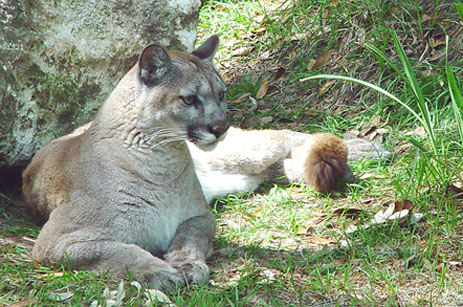 |
|||||||||||
|
|||||||||||
|
Puma concolor Photo Fiona Sunquist © You may hear the Florida panther called by several names, including puma, cougar, mountain lion and catamount, but all these names refer to the same cat. Florida panthers were thought to be extinct until 1973, when was a puma was ‘treed’ by a hunter at Fish-eating Creek near Lake Okeechobee. Today, a small, remnant population of 70-80 cats survives in south Florida. The 1973 discovery of the puma in southwestern Florida sparked new interest in the cat, and set in motion a series of efforts by state and federal agencies to ‘recover’ the population. Field surveys for the Florida puma began in the late 1970s and a clearinghouse was set up to record sightings, sign, tracks, kills, vocalizations, etc. Over a 15-year period more than 4,600 records were documented, but less than 2% were actually puma. In 1982, the Florida Panther was made the state mammal. Since 1981 more than 130 Florida panther have been radio collared and followed, mostly using light aircraft. The data show that males range over very large areas — roughly 200 sq miles (519 sq km) — while female home ranges are approximately 75 sq miles (194 sq km). A surprising number of people in Florida claim to have seen black Florida panthers. Literally hundreds of ‘sightings’ of black panthers occur in Florida every year but none have ever been authenticated. While there are black jaguars, black leopards, and even black bobcats, there are no skins or specimens of black pumas. Biologists insist that there are no black pumas in Florida, and maintain that they should know, because most Florida panthers have been radio collared, photographed, and followed since birth. Photo Fiona Sunquist © As you travel about south Florida you are likely to encounter signs warning you of “Panther crossing.” This is because collisions with vehicles are one of the principle causes of death for Florida panthers. Between January and August 2006 there were 14 panther deaths in Florida, eight of which were caused by vehicles. When “Alligator Alley” the major east-west highway across south Florida, was upgraded to a four-lane interstate (I-75), a 40-mile section of the road was fenced and equipped with 36 wildlife underpasses. Animals attempting to cross the road are funneled into the underpasses by 10-ft high chain link fences. The efforts appear to have been successful. Automatic cameras have photographed puma and other wildlife using the underpasses and no puma have been killed on Alligator Alley since underpasses were built.
|
| • Live weather radar • About Florida weather • Map & Key to Regions |

Wildlife of Florida 2011
Fiona Sunquist
Download $19.99


Wildlife of Florida: Lizards
Fiona Sunquist
Download $2.49

gator/crocs | birds | mammals | snakes | turtles | frogs/toads | lizards | sharks
Wildlife | Favorite Activities | My Destinations | about us | resources | site map | home
![]() web site development by Creative Communications
web site development by Creative Communications













